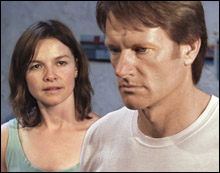
LOOK BOTH WAYS: Four Australian Academy Awards for this one? |
Here’s my favorite movie trivia question: what living film director can claim the earliest extant film? The answer: Portugal’s Manoel de Oliveira, born in 1908 and still directing, made a silent documentary, Working on the Douro River, in 1931, 75 years ago! In second place: former MIT filmmaking head Richard Leacock, born in 1921, made Canary Islands Bananas in 1935, when he was a 14-year-old fledgling documentarian.But what about a Hollywood feature?
The answer has just changed, because Vincent Sherman, a prolific Warner Brothers contract director, died June 16 at the Motion Picture & Television Fund Hospital. He was a month short of his 100th birthday. It was Sherman behind the camera for the dreadful 1939 horror movie The Return of Dr. X, with Humphrey Bogart ludicrously cast as a vampire. Never mind. Who else could brag of a Hollywood flick in the 1930s? Sherman was a craftsman, smoothly guiding big Hollywood stars through B-level movies: Joan Crawford in Harriet Craig (1950), Paul Newman in The Young Philadelphians (1959).
In a 28-year career, Sherman never once got an Academy Award. What he did do, according to his spill-some 1996 autobiography, Studio Affairs: My Life As a Film Director, is bed his leading ladies, and with the consent of Hedda, his wife. How do you get to be 99-plus? Sleep with Joan Crawford, Rita Hayworth, Bette Davis.
So who’s the new Hollywood champion? (Also recently deceased: the unknown Joseph M. Newman, who made Northwest Rangers in 1942, first film Man’s Greatest Friend in 1938. And, far more famous, Robert Wise, who made Curse of the Cat People in 1944.)
I’m betting on Stanley Donen, born in 1924, most famous for directing, with the late Gene Kelly, Singin’ in the Rain (1952). He began his career in 1949 with the MGM musical On the Town, likewise directed with Kelly. Is any studio movie earlier, dear readers? I’m happy to announce a better answer in a future “Film Culture.”
For decades, Judy Stone was San Francisco’s key film critic, reigning at the Chronicle. But except for adoring foreign-language films, she preferred doing interviews to reviewing. Inspired by her older brother, the late I.F. Stone, king of indie political journalists, she’s been a shrewd, probing questioner, never intimidated by the fascinatingly erudite people she’s talked to around the globe. Not Quite a Memoir: Of Films, Books, the World (Silman-James Press, $29.95) is a huge, impressive collection of her conversations with film people — directors, screenwriters, actors — and also essayists and novelists. I’m passing my days being entertained by Judy Stone talking to, among many others, Kathy Acker and Gus Van Sant, Maya Angelou and Selma Hayek, Doris Lessing and Abbas Kiarostami.
My favorite interview is with novelist Manuel Puig, who discusses a 1940s childhood at the bijou in the Argentine boondocks: “MGM movies were the most unreal, so they were my favorites. The more they were unlike my small town, the more I liked them.”
It’s not by business to straighten out misguided Aussies. Still, how could you Down Under guys pile all your Australian Academy Awards — four big ones! — on the made-for-TV-like Look Both Ways, which screens this weekend, July 21-24, at the Brattle? Filmmaker Sarah Watt should have stuck to her previous work of making little animations, because she’s inept at directing actors, and her soupy story of about a sad bunch of interconnected lives has been done and done before. In this one, a morbid young lady who sees death everywhere is mysteriously drawn to a young man who’s just discovered he has cancer. I didn’t believe a word of it.